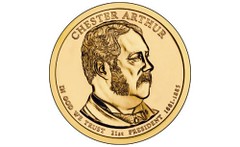
PREV ARTICLE
NEXT ARTICLE
FULL ISSUE
PREV FULL ISSUE
ARTICLE EXPLORES THREAT OF DOLLAR COIN COUNTERFEITING
This article from Slate claims it would be very easy to counterfeit U.S. coins today because so few safeguards are in place.
-Editor
If counterfeit coins sound like a problem more suited to the Arthur administration, tell that to the Europeans. The same week as McCain and Harkin announced their support of the bill, the European Commission Anti-Fraud Office released its latest report on fake coins. Their European Technical and Science Centre intercepted 157,000 bogus euro coins in 2011. The report's year-to-year figures reveal that faked 50-cent and 1-euro coins, worth about 66 cents and $1.32 respectively, have been steadily increasing in number for the last four years. Coin counterfeiting lives on as a low-tech and low-risk crime with steady returns through bulk sales to criminals and laundering via crooked storeowners and even through slot machines. In the last decade, most major coinages have been faked, including British pounds, Russian rubles, Indian rupees, Japanese yen, and Canadian dollars. Although they seize thousands of fake coins every year, both Europe and Canada have kept counterfeiting rates relatively low by actively sorting and keeping track of fakes, and then responding with countermeasures. The 1 and 2 Euro pieces have a bull's-eye-style bimetallic composition-an invention that dates back to the Romans, but that can still deter amateurs-while this year, Canada issued new $1 and $2 coins with laser-marks and electromagnetic signatures meant to deter counterfeiters. Other countries have not fared so well-and the U.K., in particular, offers a cautionary tale. The British pound is an old-fashioned gold-colored coin with a bewildering number of variant designs. In other words, it's rather like a U.S. dollar coin, if far more subtly colored and pleasingly weighty. In the early 1990s, Brits began noticing shabbily engraved and suspiciously light currency jangling their pockets; bartenders found lagers paid for with quids so soft that you could dent them on the edge of the bar. In Edinburgh's rougher pubs, the going rate for a bag of 1,000 coins was £180, while in Northern Ireland paramilitary gangs were said to be getting in on the action. One counterfeiter alone, sentenced in 2007, was found to have struck 14 million pieces; another gang, as police were closing in, dumped 13,000 coins into the River Thames. They could afford the loss: Their mint had turned a profit of about £450,000 on an initial setup cost of £10,800. But could coin counterfeiting happen here? Incredibly, we don't even know if it already has. The Secret Service is in charge of dealing with counterfeit currency; but after making Freedom of Information Act inquiries with them when the $1 presidential coin program was in full swing, I found their countermeasures appeared to be ... nothing at all . And unlike the authorities in Europe or Canada, the Secret Service has issued no reports of assaying $1 coins or looking for counterfeits. (This despite the fact that in 2003, the Secret Service announced busts in Colombia of operations creating fake Sacagawea dollars.) The U.S. Mint website doesn't even mention the possibility of fake modern circulating coinage, nor does it give instructions on how to detect them. Then again, with 25 different $1 coin designs already in circulation-the Susan B. Anthony, four Sacagawea variants, and the first 20 presidents-the $1 coin's identity has been so diluted that few would know a real from a fake anymore. Could you pick James K. Polk out of a lineup? At least one agency has taken notice of the problem inherent in proposals like the COINS Act, though: the General Accounting Office. "Senior officials at the Federal Reserve and Mint told us the increased circulation of $1 coins could increase the risk of counterfeiting," noted a GAO report last spring. Their analysis-which was otherwise rather favorable to the coin option-noted that the United States was far less prepared for such counterfeiting than other nations: "Both Canada and the U.K. created validation programs. ... The Federal Reserve banks circulate coins they receive from commercial banks, but do not have a comparable validation program."
Have any of our readers come across the mentioned fake Sacagawea dollars?
-Editor
To read the complete article, see:
Do You Know What James K. Polk Looks Like?
(www.slate.com/articles/business/cashless_society/2012/02/

Wayne Homren, Editor The Numismatic Bibliomania Society is a non-profit organization promoting numismatic literature. See our web site at coinbooks.org. To submit items for publication in The E-Sylum, write to the Editor at this address: whomren@gmail.com To subscribe go to: https://my.binhost.com/lists/listinfo/esylum All Rights Reserved. NBS Home Page Contact the NBS webmaster 
|
